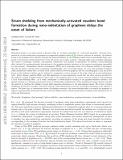| dc.contributor.author | Kumar, Sandeep | |
| dc.contributor.author | Parks, David Moore | |
| dc.date.accessioned | 2015-07-07T13:25:08Z | |
| dc.date.available | 2015-07-07T13:25:08Z | |
| dc.date.issued | 2015-01 | |
| dc.date.submitted | 2014-12 | |
| dc.identifier.issn | 1530-6984 | |
| dc.identifier.issn | 1530-6992 | |
| dc.identifier.uri | http://hdl.handle.net/1721.1/97691 | |
| dc.description.abstract | Mechanical failure of an ideal crystal is dictated either by an elastic instability or a soft-mode instability. Previous interpretations of nanoindentation experiments on suspended graphene sheets, however, indicate an anomaly: the inferred strain in the graphene sheet directly beneath the diamond indenter at the measured failure load is anomalously large compared to the fracture strains predicted by both soft-mode and acoustic analyses. Through multiscale modeling combining the results of continuum, atomistic, and quantum calculations, and analysis of experiments, we identify a strain-shielding effect initiated by mechanochemical interactions at the graphene–indenter interface as the operative mechanism responsible for this anomaly. Transmission electron micrographs and a molecular model of the diamond indenter’s tip suggest that the tip surface contains facets comprising crystallographic {111} and {100} planes. Ab initio and molecular dynamics (MD) simulations confirm that a covalent bond (weld) formation between graphene and the crystallographic {111} and {100} facets on the indenter’s surface can be induced by compressive contact stresses of the order achieved in nanoindentation tests. Finite element analysis (FEA) and MD simulations of nanoindentation reveal that the shear stiction provided by the induced covalent bonding restricts relative slip of the graphene sheet at its contact with the indenter, thus initiating a local strain-shielding effect. As a result, subsequent to stress-induced bonding at the graphene–indenter interface, the spatial variation of continuing incremental strain is substantially redistributed, locally shielding the region directly beneath the indenter by limiting the buildup of strain while imparting deformation to the surrounding regions. The extent of strain shielding is governed by the strength of the shear stiction, which depends upon the level of hydrogen saturation at the indenter’s surface. We show that at intermediate levels of hydrogen saturation the strain-shielding effect can enable the graphene to support experimentally determined fracture loads and displacements without prematurely reaching locally limiting states of stress and deformation. | en_US |
| dc.language.iso | en_US | |
| dc.publisher | American Chemical Society (ACS) | en_US |
| dc.relation.isversionof | http://dx.doi.org/10.1021/nl503641c | en_US |
| dc.rights | Creative Commons Attribution-Noncommercial-Share Alike | en_US |
| dc.rights.uri | http://creativecommons.org/licenses/by-nc-sa/4.0/ | en_US |
| dc.source | arXiv | en_US |
| dc.title | Strain Shielding from Mechanically Activated Covalent Bond Formation during Nanoindentation of Graphene Delays the Onset of Failure | en_US |
| dc.type | Article | en_US |
| dc.identifier.citation | Kumar, Sandeep, and David M. Parks. “Strain Shielding from Mechanically Activated Covalent Bond Formation During Nanoindentation of Graphene Delays the Onset of Failure.” Nano Lett. 15, no. 3 (March 11, 2015): 1503–1510. | en_US |
| dc.contributor.department | Massachusetts Institute of Technology. Department of Mechanical Engineering | en_US |
| dc.contributor.mitauthor | Kumar, Sandeep | en_US |
| dc.contributor.mitauthor | Parks, David Moore | en_US |
| dc.relation.journal | Nano Letters | en_US |
| dc.eprint.version | Original manuscript | en_US |
| dc.type.uri | http://purl.org/eprint/type/JournalArticle | en_US |
| eprint.status | http://purl.org/eprint/status/NonPeerReviewed | en_US |
| dspace.orderedauthors | Kumar, Sandeep; Parks, David M. | en_US |
| dc.identifier.orcid | https://orcid.org/0000-0002-9060-227X | |
| mit.license | OPEN_ACCESS_POLICY | en_US |
| mit.metadata.status | Complete | |
